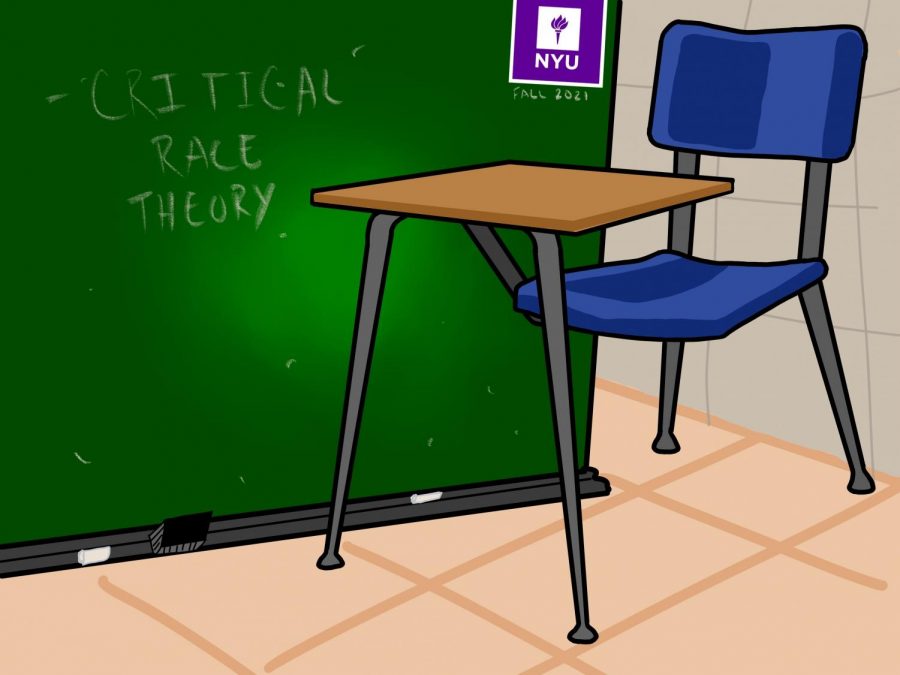Opinion: Opponents of critical race theory fail to understand its design
The rage against critical race theory comes from a place of ignorance. Education about racism is essential for students of all ages.
Recently, bills that restrict teaching critical race theory have been introduced in 27 states. In a city as diverse as New York, education about racism is extremely important. (Staff Illustration by Manasa Gudavalli)
September 10, 2021
Over the summer, Republican legislators commenced a new phase in the ongoing debate regarding how to teach history classes about our nation’s controversial policymakers. In June, legislators introduced bills that would cut funding for schools with lessons about the long-lasting effects of slavery visible throughout U.S. history. This continued into July, when a representative from Missouri proposed prohibiting the teaching of critical race theory altogether. As of Aug. 26, at least 27 states had introduced bills restricting the teaching of CRT, thereby limiting how teachers can discuss racism in the classroom.
The opposition to teaching critical race theory stems from ignorance of the field as people fail to understand that the curriculum changes in response to history’s growth over time. In a city reliant on a mixture of international races and cultures, critical race theory needs to continue being implemented in all K-12 curriculums.
New York City is just one of the many areas across the United States where protests have been held against the implementation of CRT in school curricula. For instance, a group of parents on the Upper East Side have begun protesting against CRT saying it focuses too much on oppression and how “white people hate black people”. What these individuals fail to understand is that CRT is not a training course on how to understand racism, but rather a fluid practice that explores the role of race in society and how it has shifted over time.
CRT is a field of legal scholarship that has historically sought to examine the intersection between U.S. law and racism. It has spawned academic and political movements to abolish the racist version of history that has always been taught in the American education system. Proponents of CRT suggest that racism continues to pervade the United States because history curricula is neglecting controversial topics such as race. CRT is not meant to be injected into school curricula as simply one class or training session. Rather it should be interwoven with all the teachings of a curriculum so that the effects of racism on society can be better understood through different lenses.
At NYU, students are used to a diverse liberal arts curriculum that includes history, science, literature, creative arts and students’ own interests and majors. Students are encouraged to learn about different cultures through multiple educational paths. NYU’s approach reinforces the idea that instead of running from history, we must grow as culturally competent individuals and strive towards racial justice.
But students should not have to pursue a liberal arts education to receive proper teaching about race. They should be prepared for tough conversations in college through a deeper understanding of CRT in their K-12 education. Therefore, a liberal arts education model ought to be applied in primary and secondary schools in order to better teach students about race and its role in society. As students at an international institution in a global city, we should be concerned about the flawed education that younger generations are receiving.
The purpose of teaching about race in schools is to demonstrate that race is socially constructed and to analyze the effects of this construct over time to better empathize with one another. According to the National Human Genome Institute, race is used to group people that share visible characteristics; therefore, it cannot truly be described as a biological construct. We created this construct and we now must work to undo the negative effects. This can be done through the thorough integration of CRT in all curricula so students can properly understand history over time. Discrimination and prejudice cannot be pushed aside by outlawing teaching on race. We need to further recognize our mistakes and work towards an inclusive future for all races and cultures through the implementation of CRT in K-12 education.
Contact Alexis Tretschok at [email protected].
























































































































































